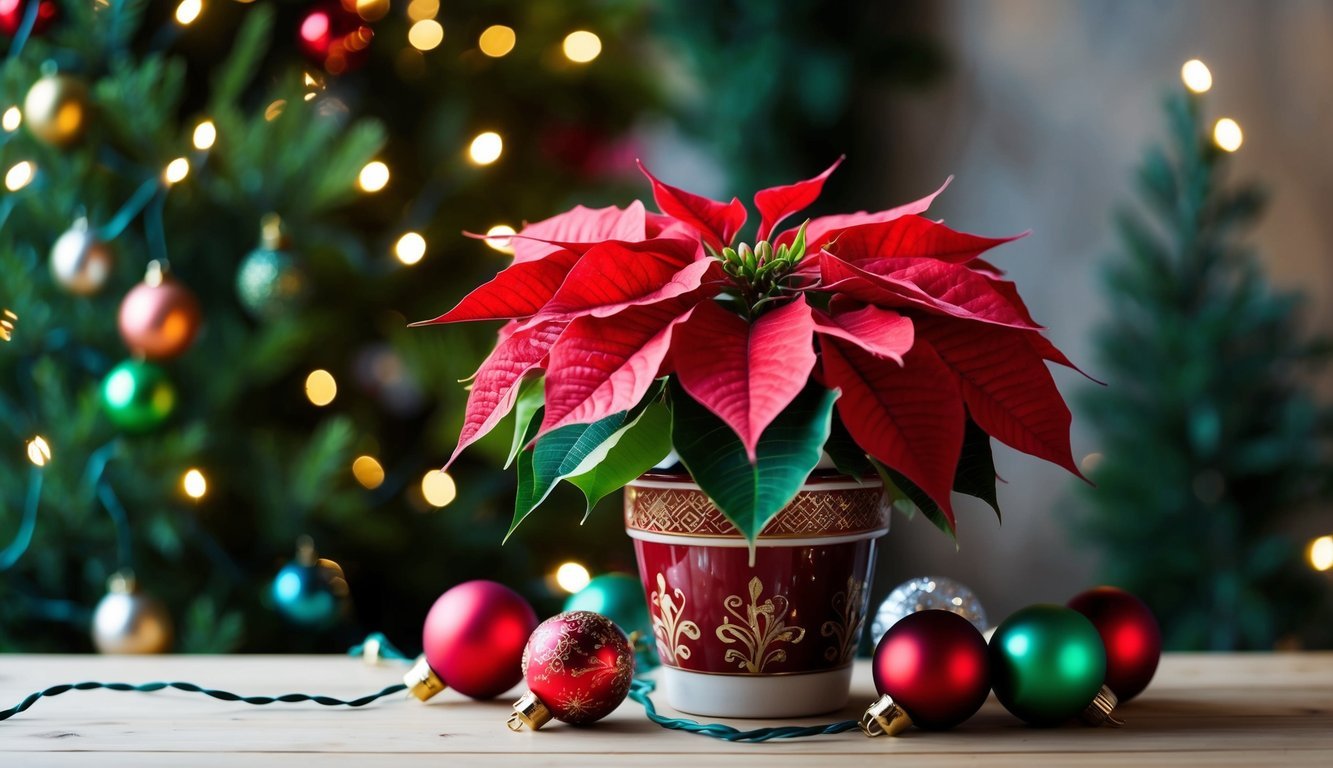
Poinsettias are the quintessential symbol of the holiday season, admired for their vibrant red bracts and festive spirit.
To ensure that your new poinsettia thrives and dazzles throughout this joyous time, follow these five crucial steps that will help keep it healthy and flourishing indoors—even in the cold of winter.
Understanding Your Poinsettia
Picture a woman in a warm white sweater, bringing home a majestic poinsettia, its deep crimson bracts and tiny yellow flowers set beautifully in a bold red pot, complemented by the backdrop of a beautifully adorned Christmas tree.
This striking image perfectly captures the essence of seasonal cheer.
As part of the Euphorbia family—which includes other unique plants like spurges and crown of thorns—poinsettias have sturdy stems filled with a distinctive milky sap.
During the shorter days of winter, these plants produce brilliant red leaf-like bracts that enhance clusters of petite yellow flowers, making them a favorite decoration for the holidays.
While many people opt to keep poinsettias indoors, they can also thrive outdoors in the right conditions, particularly within USDA hardiness zones 9 to 11.
If you’re planning to garden with your poinsettia, you can relocate it outside during warmer spells between fall and spring, ensuring it receives full sunlight but enjoys afternoon shade in hotter climates.
For those who prefer to enjoy their poinsettias indoors, it’s essential to mimic their native habitat.
Originating from the warm, sunny climate of Mexico, these plants prefer cooler temperatures in winter and vibrant sunny days.
Steps to Follow After Bringing Your Poinsettia Home
After you’ve found the perfect spot for your new potted poinsettia, take a moment to evaluate its needs.
Often, retailers prepare these plants for peak holiday appeal, so it’s important to follow these five strategies to help your new foliage flourish:
- Postpone Repotting Until Spring: You might be tempted to repot your poinsettia as soon as you get it home, but it’s best to hold off.
Winter’s typically cool and dim conditions can be hard on these plants, and moving them too soon can lead to shock and leaf drop.
Instead, consider placing the nursery pot into a decorative ceramic or terracotta container for added flair while maintaining a less disruptive environment for the plant.
As spring approaches and temperatures warm up, then you can think about repotting into a larger pot or moving it outdoors—but do this after the last frost.
- Find the Right Light: Choose a bright window as the new home for your poinsettia.
These plants flourish in bright indirect sunlight, aiming for anywhere between two and eight hours a day.
Dark areas where low-light plants thrive can spell trouble for your poinsettia, leading to leaf loss and fading blooms.
- Keep Temperatures Consistent: After bringing your poinsettia home, it’s vital to protect it from temperature extremes.
They thrive in conditions above 60°F (16°C) and should be kept away from drafts, which can quickly affect their foliage.
By maintaining a stable environment, you’ll help keep your plant lush and green.
While some individuals may thrive as evergreen plants, many will drop leaves if conditions become too unfavorable.
- Water Mindfully: Proper watering is key to your plant’s health, but understanding the right amount is crucial.
Poinsettias like their soil to remain moist without becoming waterlogged.
It’s important to let the top of the soil dry out between watering sessions to prevent root rot, so be sure not to let your pot sit in standing water.
To figure out when to water, use the finger test: stick your finger into the soil to gauge moisture.
If it feels dry, it’s time to soak it; if it remains damp, wait a bit longer.
- Don’t Worry About Leaf Drop: If your poinsettia starts shedding leaves after the holidays, there’s no need for alarm.
This behavior is perfectly normal as the plant conserves energy during winter.
When leaves begin to yellow or brown and fall off, reduce watering and consider moving your plant to a cooler spot for the rest of its dormant period.
Pruning the stems back to two or three buds can promote new growth in the upcoming season.
Store your plant in a cool, dark place during winter, and once the danger of frost has passed, you can relocate it outside during warmer months or keep it in a sunny spot indoors.
Planning for Next Year’s Blooms
If you’re keen to see your poinsettia bloom again for next season’s festivities, you can adjust its light exposure.
Blooming happens when days are shorter, so begin providing your plant with 14 hours of darkness each night starting in early October, followed by no more than 10 hours of daylight.
Maintain this cycle consistently for about ten weeks to encourage flower buds, just in time for Thanksgiving.
Additionally, consider fertilizing to boost healthy growth—start with a half dose of organic fertilizer once a month during the active growing season, and then stop feeding in late summer to prepare the plant for its bloom phase.
By following these guidelines, your new poinsettia can not only survive but also truly thrive, adding joy and vibrancy to your holiday celebrations!
Source: Epicgardening.com

